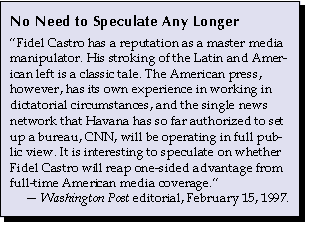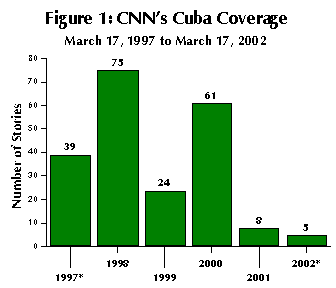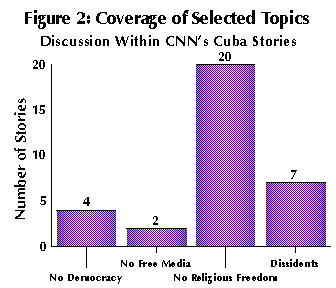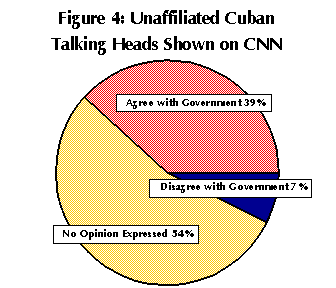 |
|||||||||||||||||||||
|
|||||||||||||||||||||
 |
|||||||||
|
|||||||||
 |
||
|
 |
||||||||||||
|
||||||||||||
 |
|||||||||||||||||||||||||||||||||||||||
|
|||||||||||||||||||||||||||||||||||||||
|
 |
|
Megaphone
for a Dictator
On Monday, March 17, 1997, CNN became the first U.S.-based news organization to open a permanent news bureau in Cuba since the Associated Press was expelled from the communist-controlled island 28 years earlier. Both the United States and the Castro regime agreed to the arrangement, with the American government requiring that “news gathering activities within Cuba be unconditioned and unrestricted.”1 Many opponents of Castro’s repressive, undemocratic regime believed the presence of free and independent reporters would help the cause of freedom.
CNN officials indicated that the goal of the network’s new Havana office would be to provide more and deeper coverage than was possible when journalists were limited to short stays on the island. Incoming bureau chief Lucia Newman told USA Today’s Peter Johnson that she wanted to accurately portray the full range of life in Cuba — “what people are like, what problems there are and how they live.”4 As for concerns that CNN reporters would be harassed by communist authorities, on the first night of her new assignment Newman assured her audience that “the Cuban government has told us that while they will be keeping close tabs on what we say and what we broadcast, we will however be given total freedom to do what we want and to work without any prior censorship. And that’s what we’re certainly looking forward to.”5 During the half decade that CNN has had a home in Havana, Fidel Castro probably has not lost much sleep worrying whether the network would reveal his dictatorship’s dirty secrets to the world. In fact, CNN has aired extremely few stories revealing the dark side of one of the world’s last communist regimes, and the network’s treatment of Castro himself is mainly docile. Dashing hopes that a free media presence would expose the regime’s abuses to the world, CNN has instead allowed itself to become Castro’s megaphone, providing the dictator with an international platform even while allowing him to claim that he’s being scrutinized by free and independent journalists. These conclusions are the result of an exhaustive analysis by the Media Research Center of all 212 stories about the Cuban government or life in Cuba which aired on CNN’s prime time news programs from March 1997 through March 2002.6 According to the MRC’s analysis, CNN reporters elevated the voices of Fidel Castro and his communist regime far above those of political dissidents or the Catholic Church, while the issues of Cuba’s dissident community, the treatment of political prisoners, and the lack of democracy in Cuba amounted to merely a tiny fraction of CNN’s news agenda. At the same time, the Cuban public was depicted as overwhelmingly supportive of the dictator and his policies, with six times as many ordinary Cubans shown on CNN expressing support for Castro’s positions than even the slightest disagreement. Instead of exposing the truth about the totalitarian regime that runs Cuba, as both Republicans and Democrats had hoped five years ago, CNN has allowed itself to become just another component of Fidel Castro’s propaganda machine.
Section 1: Burying the Bad News
As Figure 1 shows, most of CNN’s Cuba news was broadcast during the first two years after the establishment of the Havana bureau, with a rapid decline in coverage beginning in 1999. The Elian story only temporarily renewed CNN’s interest in Cuba, but the network’s coverage has waned dramatically since. Last year, CNN’s prime time news programs offered only eight stories about Cuba, and only five during the first three months of 2002. In contrast, during the same three-month period CNN presented three times as much news (16 stories) on complaints about the American military’s treatment of captured al Qaeda prisoners held in Cuba at the U.S. Naval Base at Guantanamo Bay. That amounted to more than twice as many stories, in a much shorter time frame, than the issue of Castro’s treatment of prisoners and dissidents received during the entire five-year study period (7 stories). CNN’s recent lack of interest in all Cuba news has exacerbated its tendency to virtually ignore stories illustrating the dictatorial tactics of the Castro regime. The U.N. Commission on Human Rights, the U.S. Department of State, Human Rights Watch, Amnesty International, and the Committee to Protect Journalists, among others, have over the past five years documented — and repeatedly condemned — the abuses of the Cuban government. Yet over the same period of time, CNN viewers would have had tremendous difficulty learning about the particular activities that contributed to the odious reputation of Castro and his henchmen. Analysts examined each Cuba story looking for information about four aspects of Cuba’s record on human rights: the regime’s treatment of dissidents and political prisoners; harassment and intimidation of journalists; controls on an individual’s right to free religious expression; and the lack of democracy and free elections in Cuba. We found that, despite the obvious importance of these issues to the public’s understanding of the true nature of Castro’s regime, they comprised only a tiny portion of the network’s overall Cuba coverage during the past five years. Lack of Democracy and Free Elections
The people are denied political power under a dictatorship, and ultimate authority instead rests in the hands of either a small group or a single man. This is the case in Cuba, but CNN did not present this as a problem, merely a fact of Cuban life. In 1997, rumors about Castro’s health prompted Lucia Newman to report “no one really knows what would happen if Castro were to die suddenly.” She then showed a dissident who expressed his desire that Cuba would become a democracy after Castro, but Newman threw cold water on his dreams: “Castro insists that as long as he is alive, there will be no change, no transition, except towards further revolution.”7 A few months later, in January 1998, Newman favorably contrasted Cuba’s national and provincial elections with those in the United States. “No dubious campaign spending here,” she enthused, “no mud slinging, and even less doubt about the outcome in elections where there is no competition. That is because there are as many candidates as seats to be filled, all of them by supporters of the Communist government — a system President Castro boasts is the most democratic and cleanest in the world.”
Harassment and Intimidation of Journalists One would imagine that no issue would strike more of a chord with journalists than the imprisonment, harassment and intimidation of their brethren, yet CNN presented only two stories on this topic, or less than one percent of the total coverage. It is not as though there was no news on this front. In its 2001 annual report on press freedom in the Americas, the international journalists’ group Reporters Without Borders stated that “the last country on the continent where the state exerts total control of news, Cuba, is also the only one where journalists are imprisoned.”9 In January 2001, the Associated Press reported, Fidel Castro tried to extend his control to foreign journalists, threatening reporters with expulsion if they “insulted” his regime. “Some agencies are not at all objective,” Castro declared in a speech on Cuban television. He added that some foreign correspondents “are dedicated to defaming the revolution. They have been, sometimes for years, not only transmitting lies but insults as well — insults against the revolution and against me in particular....We often know what they seek with these insults: that we adopt a drastic measure by expelling them.”10 Neither Castro’s effort at intimidation nor the Reporters Without Borders report, nor similar reports by other pro-free press organizations over the past five years, were ever mentioned on CNN. In late 1998, Newman presented one report on the trial of Cuban journalist Mario Julio Viera Gonzalez, although her focus was a physical confrontation between pro- and anti-communist demonstrators in Havana. And in April 2000, reporter Bill Delaney told viewers about a daily program running on Cuban television devoted to the Elian Gonzalez story, noting that the Gonzalez story was one about which the official media frequently allowed the Cuban people to see what the U.S. media were saying. Beyond that, there seemed no aspect of Cuban life that interested CNN less than the lack of journalistic freedom under Castro. Lack of Religious Freedom Stimulated by Pope John Paul II’s visit to Cuba in early 1998, CNN broadcast 20 stories about the issue of basic religious freedoms, or just under 10 percent of the total Cuba stories. Nearly all of those reports (18) were broadcast in the period immediately before, during, or after the Pope’s trip; from April 1998 through March 2002, CNN aired only two reports on this topic. Some of CNN’s stories gave Castro credit for loosening some of the very same restrictions he had imposed years earlier. On December 25, 1997, Newman reported on the joy that followed the reinstatement of Christmas as an official holiday after 28 years. “President Fidel Castro’s decision to restore Christmas has been overwhelmingly applauded by Christians as well as Marxists,” she stated, never even hinting at any public dissatisfaction with Castro for outlawing the holiday in the first place.11 Other stories credited the Pope for the improving situation. “Before the Pope even sets foot in Cuba, he’s changed lives and attitudes long fearful of expressing their religious beliefs in the atheist communist regime,” anchor Joie Chen summarized. “In recent months, Catholics have had a chance to worship openly, celebrate Christmas, even watch their spiritual leaders on TV. But the Vatican is anxious for more.”12 In early 1998, the assumption seemed to be that the Pope’s visit marked the beginning of a new era of religious freedom in Cuba; but five months after the Pope left, it appeared that little had really changed. In June 1998, CNN reported Catholic leaders were “frustrated about what they see as the communist government’s refusal to give the Church more latitude.” Lucia Newman told viewers that Castro was failing to hold up his end of the deal: “The Pope’s call for the world to open up to Cuba has been heard — Spain has normalized relations, Guatemala and the Dominican Republic have reinstated full diplomatic ties, Canada’s prime minister has visited the island and even Washington has eased some of its sanctions. But the pontiff’s plea for Cuba to open up to the world, for there to be change from within, has so far fallen on deaf ears, according to the Church.”13 But Castro’s failure to ease restrictions did not spark an increase in CNN’s coverage of this issue. Instead, after the Pope returned to the Vatican, the number of stories shrank to the same level as the other aspects of Cuba’s human rights record. Dissidents and Political Prisoners Out of 212 Cuba stories, Cuba’s dissidents were featured by CNN in only seven, or less than three percent of the total. By themselves, these stories were the toughest at exposing the insecurities and excesses of the Castro dictatorship, but they were so few in number that they provided only the barest hints of the story CNN could have told. For example, Joie Chen introduced a July 17, 1997 segment by asking, “What is the greatest fear of a dictator? Perhaps it is democracy. Cuban leader Fidel Castro might know something about that fear and, as CNN’s Lucia Newman tells us, the communist strongman isn’t taking any chances.” Newman’s report documented how Cuban agents arrested four prominent dissidents, including Vladimiro Roca, whose “crimes” involved writing pamphlets and holding press conferences. She gave CNN viewers the chance to hear Roca’s wife, Magaly de Armas, “They woke us up with horrible screams, hitting window bars and yelling, ‘Vladimiro, Vladimiro, open up, it’s state security,’ And when we opened the door, we couldn’t see — we were blinded by a huge light of a video camera. They were filming everything.” “Just what the charges entail has not been explained,” Newman told her audience. “The working group seeks to unify Cuba’s divided and illegal opposition movements, calling for a peaceful transition to democracy in this communist country.”14 In her story, Newman included the views of a Foreign Ministry spokesman, Miguel Alfonso, who declared that the four were “being investigated because of charges of counter-revolutionary acts, meaning against the security of the state.” Her colleague Susan Candiotti also put the communist perspective in her December 1998 report when she followed up on the case of the same four dissidents, who had by then been political prisoners for nearly 18 months without a trial. “Nobody who is a dissident is in prison here. We have people who are in jail because they have violated the law,” spokesman Alejandro Gonzalez stated.15 But Candiotti’s report included enough information for viewers to take such claims in context, including the fact that the government had charged the four — Roca, Matra Beatriz Roque, Felix Bonne and Rene Gomez Manzano — with “attempting to cause an insurrection [after] they had written a blistering attack on the communist system” — in other words, for nothing more than peacefully opposing Castro. Both reports, among the toughest Castro faced from CNN, showed how effectively good journalism could expose the truth of a dictatorship. Without taking sides, CNN had documented the arrest and prolonged detention of four peaceful dissidents. But because of their extreme infrequency — stories such as these appeared an average of only once every eight months — they also illustrate the opportunity CNN squandered to use the resources of its Havana bureau to reveal the truth about life under Castro’s dictatorship. CNN’s Cuban Agenda If the sordid details of life under totalitarianism weren’t the focus of most stories, what was? No single topic accounts for a majority of CNN’s Cuba coverage, but a common attribute of many stories was their decidedly non-political focus. They ignored Castro and communism altogether and focused instead on the tiniest slices of everyday life, which created the sense that the people there were living altogether normal lives. For example, Lucia Newman profiled a promising young ballerina and a 94-year-old guitar player. She gave viewers a peek inside Cuba’s Hotel Nacionale, where John Wayne, Frank Sinatra and Winston Churchill all once stayed. “If walls could talk, the rooms inside Havana’s famous Hotel Nacionale would have a lot to say,” reported Newman. Castro originally converted the hotel into a school, she reported, but has since restored it as a hotel for tourists, where “the famous are still coming,” including Kate Moss and Muhammad Ali.16 One hot August day, reporter John Zarrella talked to Cubans standing for hours in a long line: “The eventual reward, way up at the head of the line, is a bowl of summer-heat quenching, palate-pleasing, cover-your-face-in-it ice cream....On most days there are only a few flavors, usually chocolate, strawberry and mint. But for most Cubans, ice cream is hard to get, considered a real treat and worth waiting for.” Smiling Cuban children told Zarrella their favorite flavor is chocolate.17 Stop the presses. More serious stories were also predicated on the notion that Cuba was basically a normal country, not a nation governed by the secretive security apparatus of a dictatorship. A story by Newman in 1999 painted the United States as petty and self-defeating for not working hand-in-hand with the Cuban government to stop drug trafficking. “While Cuba has drug interdiction accords with 24 countries,” she narrated, “the nation next door — and on the receiving end of most of the world’s narcotics — the United States refuses to enter into any cooperation agreement with Havana. This despite several private and public offers this year by President Fidel Castro....If only out of enlightened self-interest, the Cuban government is anxious to work with Washington. The benefit: not only better anti-drug intelligence and technology, but perhaps the beginnings of a better relationship with its old Cold War adversary.”18 Cubans’ poverty was usually blamed on a single factor: the U.S. economic embargo. On May 7, 1998, for example, John Zarrella profiled an elderly woman, Carmen Figuearas and the extended family that live with her in a tiny basement apartment that “amounts to a cave,” in Zarrella’s words. “Five relatives live in the two rooms with her: among them her cousin Jose, an amputee; her grandson’s wife, Mercedes; and eight-month-old great-grandson Ismael are here. With other tenants, they share a bathroom down the hall past the dog. They share their space with kittens, too, needed to keep away the rats.” Zarrella never linked the poverty of the Figuearas family with Castro’s socialist economic policies: “For these people, life has always been tough, even when the former Soviet Union was pouring money into this country,” Zarrella lectured. “How much difference lifting the embargo would make on their existence, they simply don’t know....Most Cubans believe lifting the embargo would better their quality of life and perhaps, just perhaps, in the future fewer Cuban children will live like Ismael, in a crib in a tiny basement.”19 In addition to being the cause of so much misery, CNN reporters also indicated that they thought the embargo was a policy failure. “Eight presidents later, Cuba remains the enemy, the economic embargo remains in place. It was designed to punish Castro, perhaps cause his downfall, but Castro is still there — and, as far as we can tell, no weaker,” NewsNight anchor Aaron Brown told his audience in March 2002, as he introduced a story on the U.S. ban on travel to Cuba.20 “Every year, cigar lovers from around the world de-scend upon Havana for the International Cigar Festival, among them scores of Americans,” Lucia Newman reported. “They come to huff and puff on Cuban cigars and to rub shoulders with Cuban President Fidel Castro at the gala dinner and auction. But the fact is, attending this week-long cigar fest is forbidden to Americans, with the exception of journalists and a few others.” The story was a show of concern over the freedom of everyday Americans, not everyday Cubans. A sound bite from President Bush provided the only clue that all was not ideal in the communist island: “My administration will oppose any attempt to weaken sanctions against Cuba’s government until the regime...frees its political prisoners, holds democratic free elections, and allows for free speech.”21 Dancing around the fact that Cuba is a communist dictatorship is not just a way to present Cuba from a non-political perspective. Such a decision plays into the arguments of the Castro regime itself, that its totalitarian control of the island is merely a “different” system of governance, not a fundamental deprivation of the people’s right to govern themselves.
Section 2: Sources Showcased the Party Line Besides their choice of topics, another way to grade CNN’s Cuba news is to examine the different individuals the network put before viewers to tell the story. The rationale for establishing a permanent Havana bureau, after all, was that it would allow a greater diversity of opinion than merely passing along the latest pronouncements from the Castro regime, which could easily be done by monitoring the state-controlled Cuban media. On the ground, a reporter could — at least in theory — provide a far more nuanced and comprehensive view of Cuban public opinion. Cuban talking heads were easily grouped into two categories: sources with an official designation of some kind (as identified by the CNN reporter) and everyday Cubans who were interviewed by CNN as a way to capture public sentiment on an issue. Communists Dominated “Official” Talking Heads As Figure 3 shows, Fidel Castro and officials of his government were quoted six times more often than either representatives of the Catholic Church or dissidents, the only other groups which were regularly quoted by CNN at all.
Similarly, Cuba’s Catholic church leaders were given little play on CNN except when issues of religious freedom or the Pope’s visit were addressed. CNN’s Jim Bittermann, for example, paraphrased the comments of the archbishop of Santiago de Cuba at a mass held during the Pope’s trip: “The local archbishop was out-spoken. Many Cubans confused the communist party, he said, with patriotism. And he drew long applause when he told the crowd that the church represented the poor, and the poorest of the poor are those without freedom.”22 Such remarks from Catholic leaders, articulating a very non-communist perspective, were presented on CNN only one-seventh as often as statements from Castro and his spokesmen. In covering American politics, reporters will try to maintain a balance of viewpoints in their stories by either quoting opposition figures or, if circumstances do not permit it, paraphrasing the other side’s known position. For example, during a special report about Cuba at the time of Pope John Paul II’s visit in January, 1998, Christiane Amanpour summarized the anti-government perspective in a report on Cuba’s bad economy: “Wherever you go, whoever you talk to, you always hear people blame the U.S. embargo for all their woes, but the fact is that Cuba’s rigid socialist structures are as much to blame for this country’s dysfunctional economy. A few openly admit that, and they complain about a growing elite.”23 But balance such as Amanpour’s was rare. Even as CNN’s reporters allowed Castro’s officials to dominate their news, they also did not do much to counter even their most outrageous statements. Thus, after President Clinton signed a bill allowing food and medicine sales to Cuba, a report by Lucia Newman consisted solely of the regime’s perspective. “Cuba says that the new legislation is a farce, a kind of political Trojan horse which appears to improve trade possibilities with Cuba when it, in fact, leaves things the same or, in Havana’s words, worse.... Cuba’s position is, thanks for nothing.”24 Everyday Cubans Were Depicted As Pro-Castro
For example, Lucia Newman found two Cubans to comment on a public ceremony honoring “revolutionary icon” Che Guevara as his body was returned to Cuba 30 years after his death. Plucked from “seemingly endless lines” of mourners, both praised the late communist militant in a story that included no dissent: “This means a lot, because he is our heroic rebel commandant. It’s something historic for the Cuban people,” a man told CNN. “It’s a mixture of sadness, because he is not alive, but also happiness because Che is once again with us,” a woman stated.25
Conclusion: CNN’s Sugarcoated Dictatorship On February 4, 2000, CNN’s Newsstand devoted an entire story to the contents of Fidel Castro’s office, part of a recurring segment called “Cool Digs” on the workplaces of famous people. “When was the last time you saw a cup full of pencils on the boss’s desk?” asked CNN anchor Steven Frazier. “And, they do get used — look at how worn down the erasers are.... Years ago, our host worked as an attorney, defending poor people....He’s Fidel Castro, Cuba’s leader since 1959, who has been making waves lately in his fight for the return of young Elian Gonzalez.”29
Apart from the handful of stories documenting the arrest or imprisonment of peaceful dissidents, CNN usually presented Castro’s communist dictatorship as benign, and occasionally as a marvel of efficiency. After a large rally demanding that the U.S. send Elian Gonzalez to Cuba, Lucia Newman gave the dictator a compliment, of sorts: “Even President Castro’s staunchest critics have to give him credit for being able to organize such a large rally on short notice, a feat made possible by the fact that nearly every Cuban belongs to some sort of organization and every organization answers to the Cuban communist party and the state.”31 Ah, the political efficiency of the totalitarian state. Too often, CNN chose to avert its gaze from the truth of Castro’s dictatorship. CNN could have used its unique bureau to add to the American public’s knowledge of the only totalitarian state in the Western Hemisphere. But instead of enlightening the public about the regime’s repression, CNN’s Havana office has mainly provided Castro and his subordinates with a megaphone to defend their dictatorship and denigrate their democratic opponents. Recommendations For Improved Coverage Most of the coverage described in this report was broadcast before Walter Isaacson took over as Chairman of CNN last summer. He and his leadership team have a chance to transform CNN and improve the network’s performance. The following recommendations would improve CNN’s future coverage of communist Cuba: CNN Should Broadcast More Cuba Stories:
Commit to Doing Real Investigative Journalism:
Increase Coverage of Peaceful Dissidents: CNN should also draw attention to Cuba’s holding of political prisoners by regularly reporting on the findings of international groups such as Amnesty International, Human Rights Watch, and by following up on individual cases by interviewing family members and questioning Cuban authorities at every chance. If the dictatorship chooses to flout international human rights standards by imprisoning its peaceful opponents, CNN can at least use its Havana bureau to ensure the rest of the world knows about it.
Promote the Reporting of Dissident Journalists:
If CNN Officials Cannot Commit to Improved Cuban Coverage, They Should Close Their Havana Bureau: Notes
Home | News Division
| Bozell Columns | CyberAlerts
|





 Then-White House Press Secretary Mike McCurry told reporters that Clinton administration officials expected “that the reporting of truth about the conditions in Cuba would further our policy, which seeks to bring about peaceful, democratic change in Cuba.”
Then-White House Press Secretary Mike McCurry told reporters that Clinton administration officials expected “that the reporting of truth about the conditions in Cuba would further our policy, which seeks to bring about peaceful, democratic change in Cuba.”








